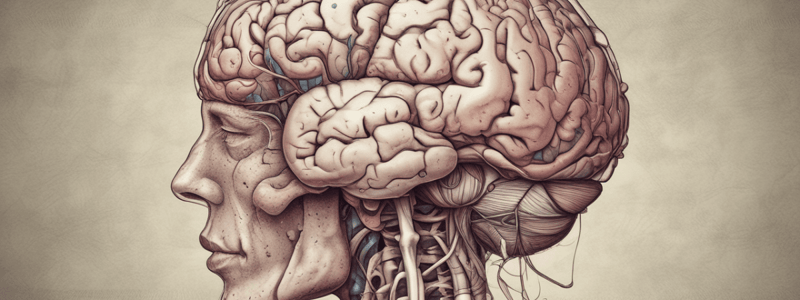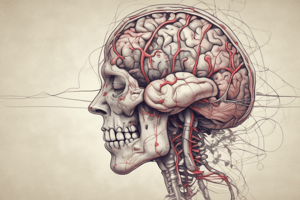Podcast
Questions and Answers
Which part of the brain is responsible for interpreting impulses and storing information as memory?
Which part of the brain is responsible for interpreting impulses and storing information as memory?
- Frontal lobe
- Cerebellum
- Brainstem
- Cerebrum (correct)
What is the function of the Broca's area in the brain?
What is the function of the Broca's area in the brain?
- Processing auditory patterns
- Interpreting visual images
- Producing speech (correct)
- Understanding written language
Which lobe of the brain is responsible for vision?
Which lobe of the brain is responsible for vision?
- Temporal lobe
- Frontal lobe
- Parietal lobe
- Occipital lobe (correct)
What is the function of the association areas in the brain?
What is the function of the association areas in the brain?
Which part of the brain is responsible for personality and speech?
Which part of the brain is responsible for personality and speech?
What is the homunculus in the brain?
What is the homunculus in the brain?
Which lobe of the brain is responsible for processing language, temperature, pressure, and touch?
Which lobe of the brain is responsible for processing language, temperature, pressure, and touch?
What is the function of the Wernicke's area in the brain?
What is the function of the Wernicke's area in the brain?
What is the primary function of the cerebrum?
What is the primary function of the cerebrum?
What is the name of the sulcus that separates the frontal and parietal lobes?
What is the name of the sulcus that separates the frontal and parietal lobes?
What is the name of the lobe buried deep in the lateral sulcus?
What is the name of the lobe buried deep in the lateral sulcus?
How many lobes are there in each cerebral hemisphere?
How many lobes are there in each cerebral hemisphere?
What structure connects the cerebral hemispheres?
What structure connects the cerebral hemispheres?
What percentage of the brain's weight is made up by the cerebrum?
What percentage of the brain's weight is made up by the cerebrum?
Which hemisphere is typically dominant in most individuals?
Which hemisphere is typically dominant in most individuals?
What is the primary function of the thalamus?
What is the primary function of the thalamus?
Which of the following is NOT controlled by the nondominant hemisphere?
Which of the following is NOT controlled by the nondominant hemisphere?
What is the function of the hypothalamus?
What is the function of the hypothalamus?
Which part of the brain consists of three parts: midbrain, pons, and?
Which part of the brain consists of three parts: midbrain, pons, and?
What is produced by the epithalamus?
What is produced by the epithalamus?
Which part of the brainstem connects the lower parts of the brainstem and spinal cord with the higher part of the brain?
Which part of the brainstem connects the lower parts of the brainstem and spinal cord with the higher part of the brain?
What is the function of the Corpora Quadrigemina?
What is the function of the Corpora Quadrigemina?
Which part of the brain regulates the rate and depth of breathing?
Which part of the brain regulates the rate and depth of breathing?
What is the function of the Pyramidal Tract?
What is the function of the Pyramidal Tract?
What is the Cerebral Aqueduct?
What is the Cerebral Aqueduct?
Which part of the brain is responsible for conducting ascending and descending impulses between the brain and spinal cord?
Which part of the brain is responsible for conducting ascending and descending impulses between the brain and spinal cord?
What is the function of the Reticular Formation?
What is the function of the Reticular Formation?
Which part of the brain is the second largest part?
Which part of the brain is the second largest part?
What is the approximate volume of cerebrospinal fluid in the human body?
What is the approximate volume of cerebrospinal fluid in the human body?
What is the main function of the arachnoid villi in the cerebrospinal fluid system?
What is the main function of the arachnoid villi in the cerebrospinal fluid system?
What is the main characteristic of the blood-brain barrier?
What is the main characteristic of the blood-brain barrier?
What is the primary function of cerebrospinal fluid?
What is the primary function of cerebrospinal fluid?
During which stage of sleep do brain activity and heart rate increase?
During which stage of sleep do brain activity and heart rate increase?
What is the term for the type of sleep characterized by rapid eye movements and increased brain activity?
What is the term for the type of sleep characterized by rapid eye movements and increased brain activity?
Flashcards
Main Brain Divisions
Main Brain Divisions
The brain consists of the cerebral hemispheres, diencephalon, and brain stem.
Cerebral Lobe Divisions
Cerebral Lobe Divisions
The cerebral hemispheres are divided into the frontal, parietal, temporal, and occipital lobes.
Frontal Lobe Function
Frontal Lobe Function
Responsible for motor activity, personality, and speech.
Parietal Lobe Function
Parietal Lobe Function
Signup and view all the flashcards
Temporal Lobe Function
Temporal Lobe Function
Signup and view all the flashcards
Occipital Lobe Function
Occipital Lobe Function
Signup and view all the flashcards
Central Sulcus
Central Sulcus
Signup and view all the flashcards
Longitudinal Fissure
Longitudinal Fissure
Signup and view all the flashcards
Lateral Sulcus
Lateral Sulcus
Signup and view all the flashcards
Parieto-occipital Sulcus
Parieto-occipital Sulcus
Signup and view all the flashcards
Left Hemisphere Function
Left Hemisphere Function
Signup and view all the flashcards
Right Hemisphere Function
Right Hemisphere Function
Signup and view all the flashcards
Diencephalon Divisions
Diencephalon Divisions
Signup and view all the flashcards
Thalamus Function
Thalamus Function
Signup and view all the flashcards
Hypothalamus Function
Hypothalamus Function
Signup and view all the flashcards
Epithalamus Function
Epithalamus Function
Signup and view all the flashcards
Brainstem Divisions
Brainstem Divisions
Signup and view all the flashcards
Midbrain Function
Midbrain Function
Signup and view all the flashcards
Pons Function
Pons Function
Signup and view all the flashcards
Medulla Oblongata Function
Medulla Oblongata Function
Signup and view all the flashcards
Cerebellum Function
Cerebellum Function
Signup and view all the flashcards
Cerebrospinal Fluid (CSF)
Cerebrospinal Fluid (CSF)
Signup and view all the flashcards
Hydrocephalus
Hydrocephalus
Signup and view all the flashcards
Blood-Brain Barrier (BBB)
Blood-Brain Barrier (BBB)
Signup and view all the flashcards
Slow Wave Sleep
Slow Wave Sleep
Signup and view all the flashcards
Rapid Eye Movement (REM) Sleep
Rapid Eye Movement (REM) Sleep
Signup and view all the flashcards
Study Notes
Brain Structure and Regions
- The brain is divided into 3 main parts: cerebral hemispheres, diencephalon, and brain stem
- Cerebral hemispheres are divided into 4 lobes: frontal, parietal, temporal, and occipital
- Each lobe is responsible for different functions:
- Frontal lobe: motor activity, personality, and speech
- Parietal lobe: language, temperature, pressure, and touch
- Temporal lobe: hearing, smell, and language input
- Occipital lobe: vision
Central Sulcus and Fissure
- Central sulcus separates the frontal and parietal lobes
- Longitudinal fissure divides the cerebral hemispheres into right and left sides
- Lateral sulcus separates the temporal lobe from the frontal and parietal lobes
- Parieto-occipital sulcus divides the occipital and parietal lobes
Cerebral Hemispheres
- The cerebrum is divided into the left and right hemispheres
- The left hemisphere is dominant in most individuals, controlling speech, writing, reading, verbal skills, and analytical skills
- The right hemisphere is responsible for nonverbal tasks, motor tasks, and understanding musical and visual patterns
Diencephalon
- The diencephalon is divided into 3 parts: thalamus, hypothalamus, and epithalamus
- Thalamus: relays sensory information to the cerebral cortex and acts as a sensory relay station
- Hypothalamus: regulates body temperature, hunger, thirst, and sleep, and maintains homeostasis
- Epithalamus: forms the roof of the third ventricle and houses the pineal body, which produces melatonin
Brainstem
- The brainstem is divided into 3 parts: midbrain, pons, and medulla oblongata
- Midbrain: contains bundles of fibers that connect the lower parts of the brainstem and spinal cord with the higher part of the brain
- Pons: helps regulate breathing and relays nerve impulses
- Medulla oblongata: conducts ascending and descending impulses between the brain and spinal cord, and contains cardiac, vasomotor, and respiratory control centers
Cerebellum
- The cerebellum is responsible for coordinating muscle movements and maintaining posture
- It is located at the base of the brain and is divided into two hemispheres
Cerebrospinal Fluid
- CSF is a clear fluid that circulates in the ventricles, central canal of the spinal cord, and the subarachnoid space
- It is produced by the choroid plexuses and is secreted into the ventricles
- CSF cushions the brain and spinal cord, and helps maintain stable ion concentrations in the CNS
Hydrocephalus
- Hydrocephalus is a condition where there is excess CSF in the brain, leading to increased pressure on the brain tissue
- It can be caused by blockages in the flow of CSF, or by an overproduction of CSF
Blood-Brain Barrier
- The blood-brain barrier is a specialized barrier that separates the brain from the blood
- It is formed by tight junctions between endothelial cells of brain capillaries
- It is highly selective and allows only certain substances to pass through, while excluding others
Sleep
- There are two types of sleep: slow wave sleep and rapid eye movement (REM) sleep
- During slow wave sleep, the brain waves slow down, and the body becomes less responsive to stimuli
- During REM sleep, the brain is active, and dreams occur
Studying That Suits You
Use AI to generate personalized quizzes and flashcards to suit your learning preferences.



